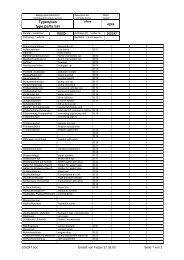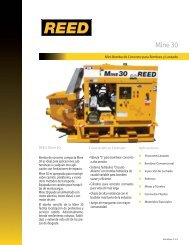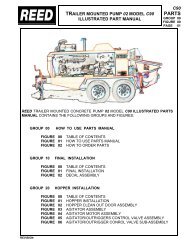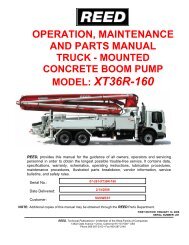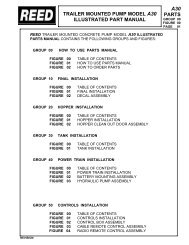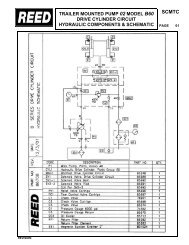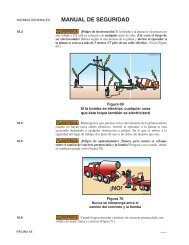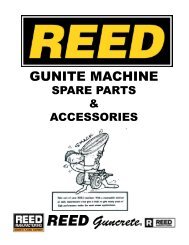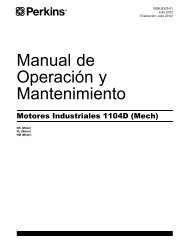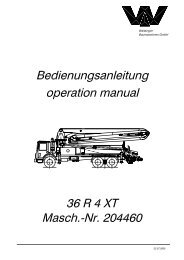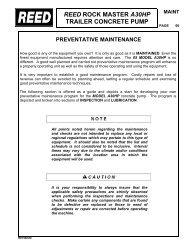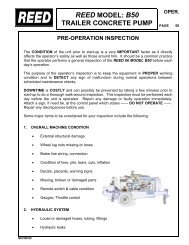Perkins Motor Operation and Maintenance Manual (English) - REED
Perkins Motor Operation and Maintenance Manual (English) - REED
Perkins Motor Operation and Maintenance Manual (English) - REED
Create successful ePaper yourself
Turn your PDF publications into a flip-book with our unique Google optimized e-Paper software.
SEBU8325-01 51<br />
<strong>Maintenance</strong> Section<br />
Aftercooler Core - Clean/Test<br />
i02690449<br />
Aftercooler Core - Clean/Test<br />
1. Remove the core. Refer to the OEM information<br />
for the correct procedure.<br />
2. Turn the aftercooler core upside-down in order to<br />
remove debris.<br />
Personal injury can result from air pressure.<br />
Personal injury can result without following proper<br />
procedure. When using pressure air, wear a protective<br />
face shield <strong>and</strong> protective clothing.<br />
Maximum air pressure at the nozzle must be less<br />
than 205 kPa (30 psi) for cleaning purposes.<br />
3. Pressurized air is the preferred method for<br />
removing loose debris. Direct the air in the<br />
opposite direction of the fan's air flow. Hold the<br />
nozzle approximately 6 mm (.25 inch) away from<br />
the fins. Slowly move the air nozzle in a direction<br />
that is parallel with the tubes. This will remove<br />
debris that is between the tubes.<br />
4. Pressurized water may also be used for cleaning.<br />
The maximum water pressure for cleaning<br />
purposes must be less than 275 kPa (40 psi). Use<br />
pressurized water in order to soften mud. Clean<br />
thecorefrombothsides.<br />
NOTICE<br />
Do not use a high concentration of caustic cleaner to<br />
clean the core. A high concentration of caustic cleaner<br />
can attack the internal metals of the core <strong>and</strong> cause<br />
leakage. Only use the recommended concentration of<br />
cleaner.<br />
Personal injury can result from air pressure.<br />
Personal injury can result without following proper<br />
procedure. When using pressure air, wear a protective<br />
face shield <strong>and</strong> protective clothing.<br />
Maximum air pressure at the nozzle must be less<br />
than 205 kPa (30 psi) for cleaning purposes.<br />
8. Dry the core with compressed air. Direct the air in<br />
the reverse direction of the normal flow.<br />
9. Inspect the core in order to ensure cleanliness.<br />
Pressure test the core. If necessary, repair the<br />
core.<br />
10. Install the core. Refer to the OEM information for<br />
the correct procedure.<br />
11. After cleaning, start the engine <strong>and</strong> accelerate<br />
theenginetohighidlerpm.Thiswillhelpinthe<br />
removal of debris <strong>and</strong> drying of the core. Stop the<br />
engine. Use a light bulb behind the core in order<br />
to inspect the core for cleanliness. Repeat the<br />
cleaning, if necessary.<br />
Aftercooler Core - Inspect<br />
i02690450<br />
Note: Adjust the frequency of cleaning according to<br />
the effects of the operating environment.<br />
Inspect the aftercooler for these items: damaged fins,<br />
corrosion, dirt, grease, insects, leaves, oil, <strong>and</strong> other<br />
debris. Clean the aftercooler, if necessary.<br />
For air-to-air aftercoolers, use the same methods that<br />
are used for cleaning radiators.<br />
5. Back flush the core with a suitable cleaner.<br />
6. Steam clean the core in order to remove any<br />
residue. Flush the fins of the aftercooler core.<br />
Remove any other trapped debris.<br />
7. Wash the core with hot, soapy water. Rinse the<br />
core thoroughly with clean water.<br />
Personal injury can result from air pressure.<br />
Personal injury can result without following proper<br />
procedure. When using pressure air, wear a protective<br />
face shield <strong>and</strong> protective clothing.<br />
Maximum air pressure at the nozzle must be less<br />
than 205 kPa (30 psi) for cleaning purposes.



